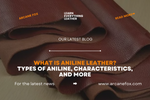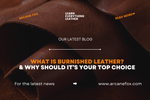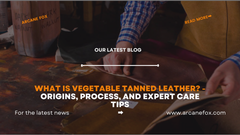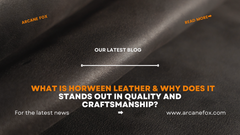What is Semi-Aniline Leather? History, Characteristics, And More
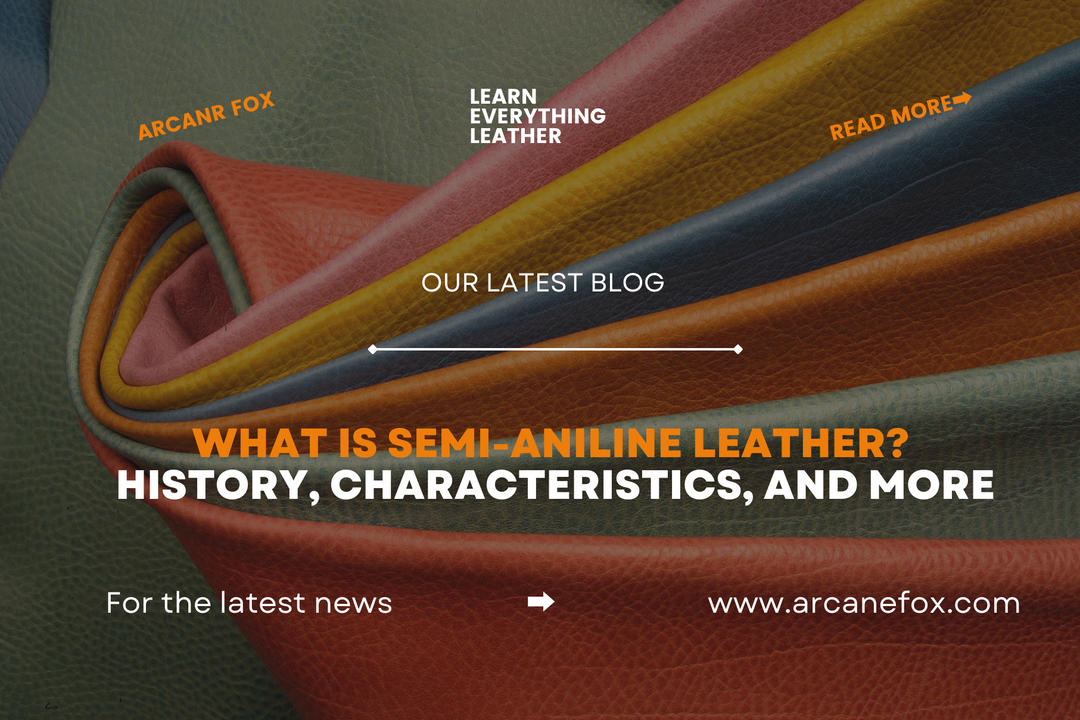
What is Semi-Aniline Leather? History, Characteristics, And More
I want to convey what I've learned about semi-aniline leather and why it can be the ideal choice after seeking leather for my handbags that deliver consistency and longevity.
Full-grain or top-grain leather that has a thin layer of surface pigment is known as semi-aniline leather. This coating provides a more consistent color and wear-resistant properties. High-quality furniture, coats, and purses are made from semi-aniline leather, which may be found for $8 to $20 per square foot.
Why is semi-aniline leather so distinctive, then? Let's examine its advantages and when it becomes the best option.
1. What is Aniline Leather?

Aniline leather sometimes referred to as full-aniline or pure-aniline leather is top-grain leather that has been dyed with a translucent, pigment-free dye after the tanning process. This sort of dye, known as aniline dye, improves the leather's appearance without changing its color or covering up any flaws; rather, it highlights them and lets the hide's intrinsic characteristics, such as scars, come through. As a result, only the best hides with minimal markings are chosen to go through the full-aniline procedure. The color used also provides some, although not much, protection against spills.
2. What is Semi-Aniline Leather?

In addition to being dyed after tanning, semi-aniline leather also goes through a more thorough procedure than full-aniline leather. The coloured dye used to create semi-aniline leather gives the final hide a consistent color throughout, with the option of funkier colors that don't appear naturally in cattle. The use of less expensive, more imperfect hides is made possible by the opaque and colorful dye, which successfully masks any flaws in the natural hide. Semi-aniline leather receives a protective top coat in addition to this color treatment to shield it from scuffs, sunlight, and other wear.
3. Which is Better Aniline or Semi-Aniline Leather?

So, aniline or semi-aniline leather, which is best for your leather chair or sofa? Neither is inherently superior than the other because, depending on your needs, each has advantages and disadvantages of their own.
A lovely leather is aniline. The natural beauty of the leather is allowed to come through because the dye is translucent. Aniline leather will age better than semi-aniline leather over time due to its more natural appearance, which is one of the main reasons why many people appreciate leather in the first place. The better feel of aniline leather against the skin is another advantage.
Natural leather is brittle. It can be readily scratched with just a fingernail, fades in the sun, stains easily from liquids, and, if not properly maintained, can even dry out. Due to the high-quality skins used, it frequently (but not always) tends to be more expensive and requires significantly more frequent care than semi-aniline.
Semi-aniline leather is significantly stronger. This leather has a protective coating that makes it resistant to scuffs, spills, stains, and sun damage, making it far more durable and requiring much less upkeep. Naturally, for individuals who have children and pets, semi-aniline leather is frequently the more sensible option. But there are drawbacks to that coating as well.
Because there is more distance between you and the leather, semi-aniline lacks the buttery smoothness of aniline leather. Although it is still compose of genuine full-grain leather, it might sometimes feel a little more synthetic.
You will ultimately need to choose between the carefree durability of semi-aniline leather and the natural feel and beauty of full-aniline leather in order to satisfy your priorities. Take a look at the examples of furniture upholstered in each material below to aid in your decision.
4. History of Semi Aniline Leather
The successor of aniline leather, which was developed in 1826, is semi aniline leather, which is regarded as one of the most high-quality and natural ways to color leather. The leather was dyed with aniline, allowing the natural leather to show through. Semi-aniline leather covering works to cover up flaws like scars and insect bites.
However, the desired natural appearance of the leather's pores is still preserved. Despite being referred to as "semi" aniline, the word itself is deceptive. Semi-aniline leather is aniline leather that has had further colored treatment to give it special characteristics.
5. How Semi Aniline Leather is Made?
Aniline leather must first be produced before semi-aniline leather may be produced. The first step in this procedure is to choose premium full-grain or top-grain leather, which is then tanned in a drum with aniline colors. This leather is given a protective wax or oil mixture and pigment. When complete, this will result in the protected, homogeneous finish that is characteristic of semi-aniline leather.
6. Characteristics of Semi Aniline Leather
6.1 Surface Texture
Semi-aniline leather has a coating put to it that makes it seem smooth to the touch and slightly waxy. Even leather scars, insect bites, branding marks, and other flaws can be concealed by this coating.
6.2 Is semi aniline leather Flexible?

The fashion and furniture industries utilize a lot of semi-aniline leather, which calls for soft, flexible leather. Because of this, the majority of hides offer little stiffness and high flexibility. However, as the shoe industry has discovered, some semi-aniline leathers may be manufacture to be stiffer.
6.3 Is semi aniline leather soft?
The smoothness of semi-aniline leather is among its most appealing features. Semi-aniline leather is often made in a drum using a tanning technique that tumble-dyes the leather hide. The leather fibers become softer due to this motion.
6.4 Is semi aniline leather Sewable?
Semi-aniline leathers have a coating added to them, but this does not alter the workflow in any way; nonetheless, because this leather is softened, stitching will be simpler because there is less resistance when pulling the threads, and cutting and punching will still be possible as with other leathers.
6.5 Is semi aniline leather Durable?

Leather that is semi-aniline is incredibly robust. It is resistant to wear, water, and light thanks to its shielding pigmented covering. The added advantages of an additional finishing coat are discussed by Sevgi Nalbat, Ersin Onem, Bahri Basaran, Ali Yorgancioglu, and Onur Yilmaz of the EGE University in Bornova, Turkey. They discovered that adding the coat strengthened the tensile strength of semi-aniline leather.
6.6 Ease of Maintenance
The ease of maintenance is another fantastic advantage of the protective coating. The covering keeps wear and debris out while keeping hydration within. Semi-aniline leather won't actually require as much maintenance as its rivals.
6.7 Colors
The colored aniline coating is added to help even out the colors of the leather. As a result, the hide has a wide range of colors with little to no variation throughout, enabling consistency. Given that there are semi-aniline leathers that are both vegetable and chromium-tanned, there is no restriction on the color that aniline leather can be.
6.8 Is semi aniline leather waterproof?
Despite having increased water resistance, semi-aniline leather is not waterproof. A spill will bead off the leather, but if you wait too long to clean it up, it can soak through the protective layer and harm the leather. When dealing with any liquid, dab the area instead of wiping it, since this could push the liquid deeper into the leather.
6.9 What Cost of semi aniline leather?
The price of semi aniline leather reflects its excellence because it is typically create from high-grade leather hides and offers the further advantages of the added coating. Prices for these leathers range from $8 to $20 per square foot.
7. What are the Pros and Cons of Semi Aniline Leather?
7.1 Pros of Semi Aniline Leather
Semi-aniline leathers have many of the opulent qualities that consumers typically associate with leather. Because it is flexible and soft, using or wearing it is comfortable. Semi-aniline leather can be utilize in harsher environments without having additional maintenance because it is strong and minimal maintenance. Finally, it is homogeneous and colorful, giving projects and items a faultless appearance.
7.2 Cons of Semi Aniline Leather
Semi-aniline leather has several drawbacks, although they are primarily personal preferences because of its great quality. Usually, the problem is the colored coating on the leather. Some people like the appearance of the natural scars, bites, and markings that leather naturally develops over time.
For some creative applications, semi-aniline leather may be too flexible, necessitating the use of reinforcement materials to achieve the desired firmness. Last but not least, some people on a budget may be turn off by the price of the leather because it might be more expensive than others due to its quality.
8. What are Uses of Semi Aniline Leather?

- Bags
- Shoes
- Clothing
- Leather jackets
- Wallets
- Furniture
- Skirts
- Belts
9. Examples of Items Made From Semi Aniline Leather
Semi-aniline leather is prefer because of its adaptability, toughness, and consistent color. Because of this, it provides the ideal leather for rugged outdoor items like handbags and coats. A spill-resistant barrier is create by the color coating, simplifying maintenance. Shoes and furnishings are examples of items that benefit from these characteristics.
10. Expert Advice About Semi Aniline Leather Selection and Use
I mailed BuyLeatherOnline, an Italian distributor with a big assortment of semi-aniline leather, an email. The price distinction between semi-aniline and full-aniline leather was the subject of my initial inquiry because semi-aniline is clearly less expensive.
These skins are both "high quality," their spokesman assured me right away, but the price variation is due to rarity and original marks. They gave a full explanation of how undesirable marks could initially appear on semi-aniline leather before the pigmented layer was apply because it would hide the flaws. On the other hand, complete aniline leather requires the highest level of perfection.
Then, I inquired as to the ideal application for it and whether there were any qualities I should be aware of. They said that although this leather could "be use anywhere," "purses and shoes" were the ideal applications for it.
They merely wanted me to be aware of the potential lack of patina as the one distinguishing feature. My main lesson was that semi aniline leather might not be the greatest option if I wanted a more natural-looking leather, even though they recommended some specific hides in lighter colors if I wanted a more natural development over time.
11. Semi Aniline Leather Care and Maintenance

11.1 How to Clean Semi Aniline Leather?
When it comes to cleaning, semi-aniline leather has special characteristics. Traditional water-based cleansers can be use on it thanks to its coating. Apply the water-based or leather-specific cleaning of your choice and wipe the leather down. Prior to using more of the cleaner, it is crucial to test it first. After cleaning, the leather needs to be dry dry to remove any remaining moisture.
11.2 How to Condition Semi Aniline Leather?
Semi-aniline leather can be treat with any cream or conditioner for leather. The conditioner may take longer to absorb into the leather, though, because of the additional covering. To evenly hydrate the leather, apply the conditioner with a delicate cloth and rub it in small circular motions.
11.3 How to Store Semi Aniline Leather?
Semi-aniline leather is tough, but it should be stored away from direct sunlight and in a dry atmosphere to prevent deterioration.
12. Conclusion
Consider semi-aniline leather for things you want to last for a long time while selecting the correct leather goods for yourself. Although they may cost more up front, if properly cared for, these objects can last a lifetime.
Learn more about leather here Leather 101 - The Ultimate Guide to Different Types of Leather
Related Topics
What is Aniline Leather? Types of Aniline, Characteristics, And More
What is Burnished Leather? & Why Should It’s Be Your Top Choice
What is Antique Leather? & Why it is So Popular
What is Bicast Leather? Myths, Facts, and Benefits
What is Embossed Leather? & How to Use This Process
What is Embroidery Leather? & What to Look for In Leather Embroidery?
What is Faux Leather? It’s Quality & Durability Against Other Leather!
What is Nappa Leather? Quality, Characteristics, and Maintenance
What is Nubuck Leather? & How is it Different From Suede Leather
What is Oil or Pull-Up Leather? It’s Durability, Characteristics, and Maintenance
What is Patent Leather? & How to Maintain It’s Quality and Shining
What is Pigmented Leather? How is it Made, It's uses and characteristics

